
Colpomenia peregrina
Oyster Thief, Bulb Seaweed, Round Brown Bag
7 May 2023
Terrace Beach, Ucluelet, Vancouver Island, B.C., Canada
Low Tide: 0.8 feet at 08:31am PDT (measured at Tofino Tidal Station)
Conditions: Mix of sun and cloud, light variable winds, sea smooth, humidity 90%, 8˚C.
Moon: Waning gibbous (94.8, 18 days); Previous Phase, Full Moon, 5 May 2023 at 10:34am PDT; Next Phase, Third Quarter, 12 May 2023 at 7:28am PDT.
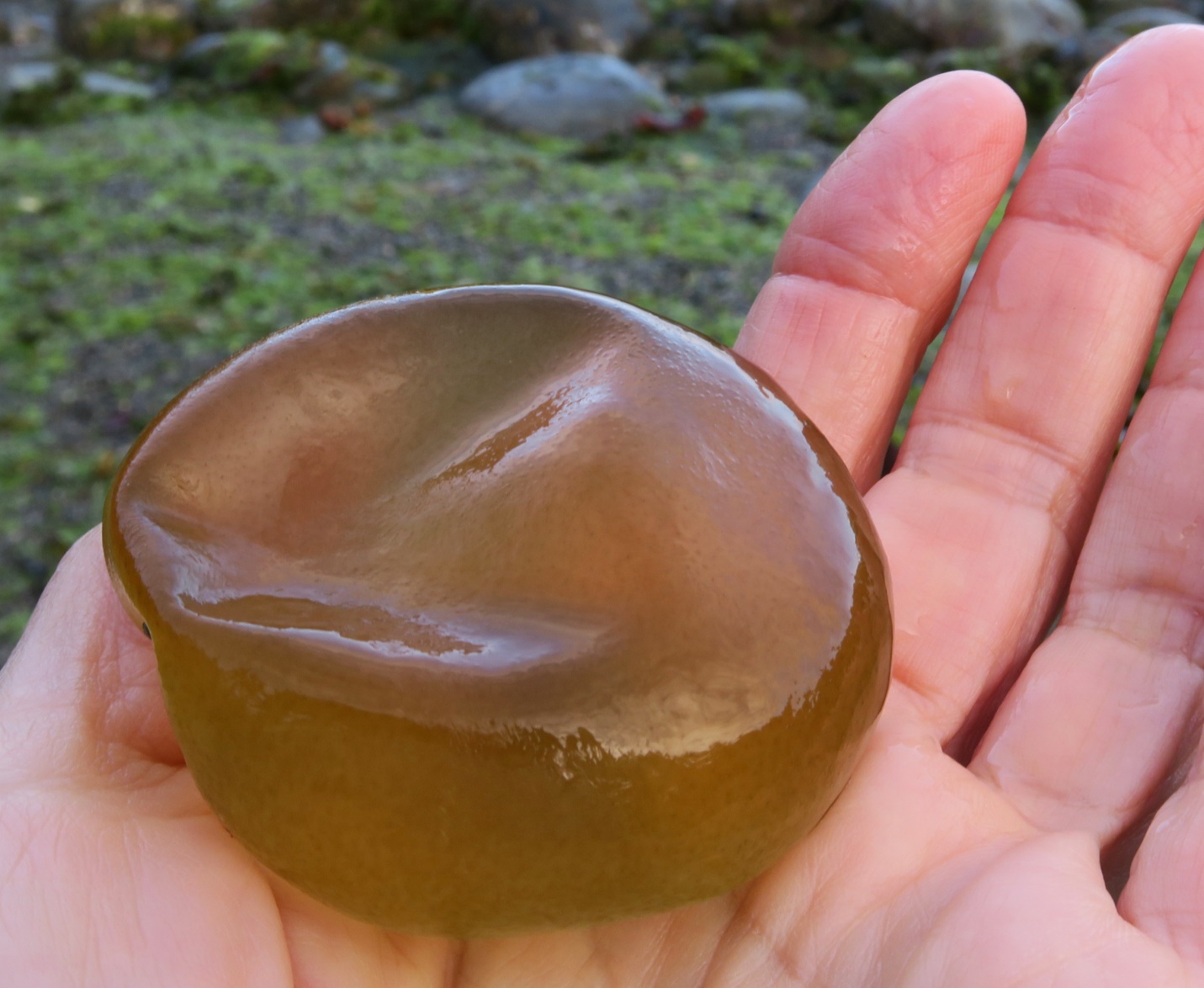
Figure 1: The first “wandering” Colpomenia seaweed found on this day is held up for a ‘portrait’. Terrace Beach, Ucluelet, Vancouver Island, B.C., Canada. May 7, 2023. Photo ID 27583 ©Seaweedwhisperings.com
Person 1:
Some specimens round, smooth and full, like fat Buddhas.
Quite variable in shape and size, some very crinkled.
Many specimens were “free” of a substrate.
Loners.
Lazy, very lazy.
Seem to want to drift through life.
Seems to attach to almost anything, but not clingy.
Attached for convenience, not to form meaningful bonds.
Some look like green-colored jellyfish.
Self-absorbed, inward thinking.
Not concerned about what others think of it.
Comical to others.
Eccentric.
Found myself “meditating” crossed-legged, Buddha-like.
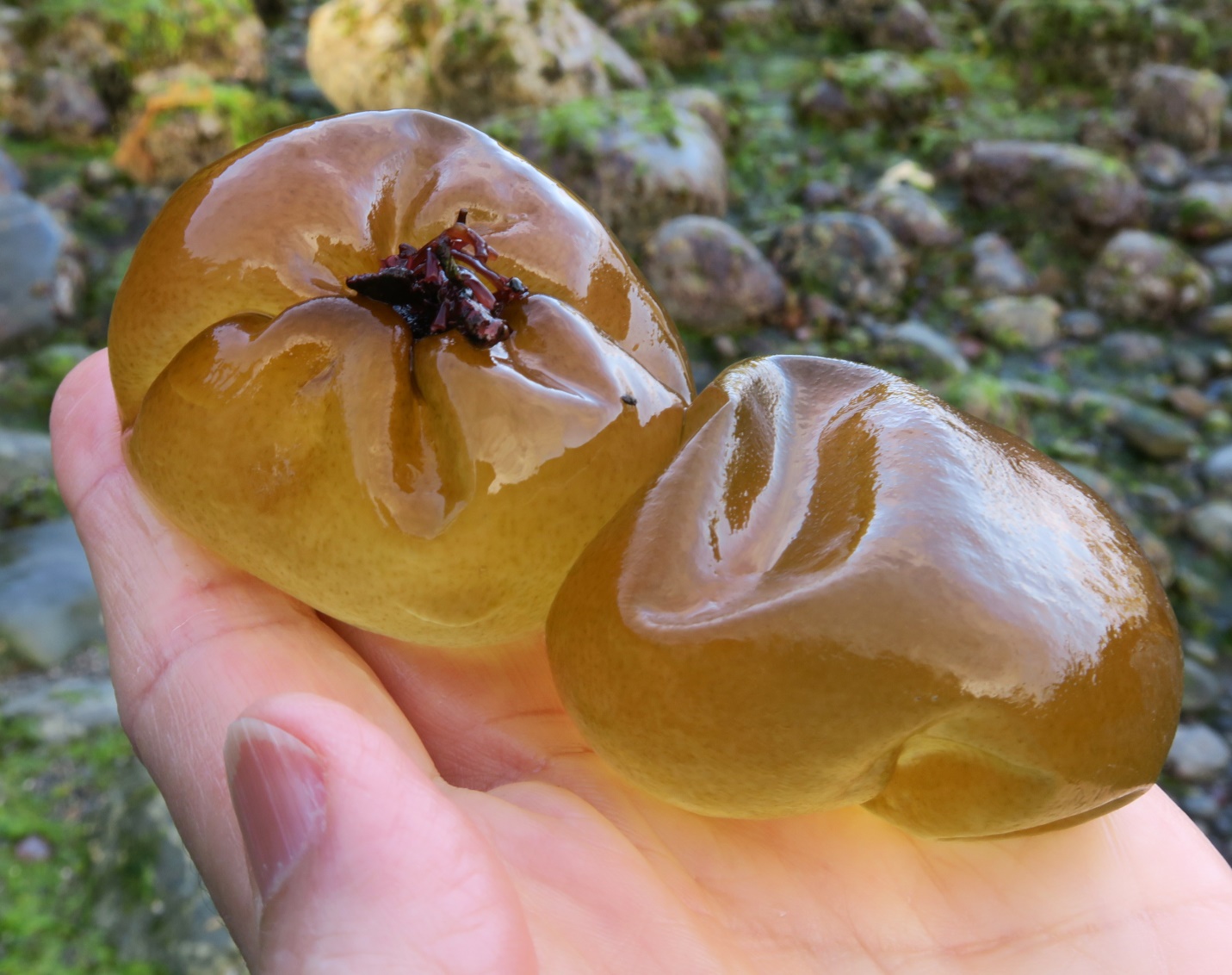
Figure 2: Soon many other “wanderers” were discovered; recent conditions had resulted in many of them being torn from their anchor points. Dislodged yet entire, like these two are, and filled with gas, they will float and move with the tides and currents. One individual is held upside down and you can see part of the compact holdfast and also fragments of other red algae that were either the anchor or also anchored to the same substrate or other algae where Colpomenia had been affixed. Terrace Beach, Ucluelet, Vancouver Island, B.C., Canada. May 7, 2023. Photo ID 27584 ©Seaweedwhisperings.com
Person 2:
When we arrived at Terrace Beach, our chosen destination for this lowest tide of our visit, I looked at the terrain of the beach and I thought, “Oh, I wonder about this...?” I felt a slight sense of trepidation, as in, “Did I blow it?” “Is this the wrong place to have come for this low tide?” “Will the area disappoint?”
Then almost before I walked twenty paces on the gravel beach down towards the receding water line, I encountered a plump, round, water-filled and vibrantly fresh Colpomenia peregrina. I thought, “Oh, hello, look at you!” It was hardly three or more paces taken before I found another Colpomenia individual, one in almost the same size and condition.
Yes, excellent condition, but it was clear that would not persist unless these individuals were washed back out to sea with the next tide. Both these first two, and then many, many others later found, had been torn or dislodged from their anchor points. In fact today I think we found more dislodged ones, than ones attached to the substrate.
The prime specimens I first found are yellow-brown flattened spherical globes that have a smooth but somewhat matte-finish surface that when nicely wet and hydrated, both inside and out, feels reasonably sturdy.
The child in me, the playful or mischievous one, thought, “Oh, this is the perfect water bomb!” But, I also wondered just how hard I’d have to throw it to cause the tidy sphere of algae to break. I am not going to experiment in this manner I decided, as I want to put these back at the seaside. I’ll let the fates decide if they’ll be washed out to sea again; I do not want to be the one to condemn these quirky algae to their death.
The top of these hollow globes are quite smooth, but the underside puckers as it gathers in to the central holdfast area. In this individual I see five main wrinkles that radiate out from the central holdfast area. It is a pleasing and simple morphology.
When I look at the “skin” of the globe as it is backlit I see that the entire surface is covered in small slightly darker-colored spots. Perhaps the tissue is thicker at these spots / dots. It is a very regular patterning to the surface of the thallus of this seaweed.
When I handle this Colpomenia it seems to release some water. Maybe the dotted “skin” is actually porous – allowing water in when needed and out also when needed.
One specimen I found was dislodged and severely torn and had no water holding capacity any longer. I tugged a bit and it ripped easily. It tore in a somewhat clean line which had only some jags to the edge.
Inside this specimen I could feel that this is where the texture of the dots is the most expressed. The inside feels moderately rough – somewhat like well-used sandpaper. The outside feels smooth like well-tanned leather.
I am sitting on my butt here writing these notes on the pebbly upper part of Terrace Beach. I noticed now that my butt is getting sore. I then chuckled to wonder if Colpomenia ever gets tired of resting on its butt, too! Probably this would only happen if it is exposed at low tide. Otherwise, when it is submerged underwater, or even partially underwater, the surrounding sea would provide lift – this would ease any weight felt by the Colpomenia butt. I, however, am not so fortunate. I will want to get up and move soon.
Butt...
The BUTT of jokes...
Colpomenia, you are an odd looking seaweed! Do you suffer a lot of teasing?
Are you put down? Called names..., compared as less-than..., because you are so different?
Possibly this occurs, AND you do look pretty self-contained. Inside, though, are you so totally smooth and OK about this...?
If conditions are too harsh, you can float off to sea, untethered completely and yet capable of living on in that voyage; is there the possibility then of finding a new and hospitable home?
Well, maybe...
In fact, it seems that you don’t really mind where it is that you “rest your butt”. I think that is often very true; you’re not picky in this way, Colpomenia, you haven’t developed your own tastes yet to be nearly quite so discerning or selective.
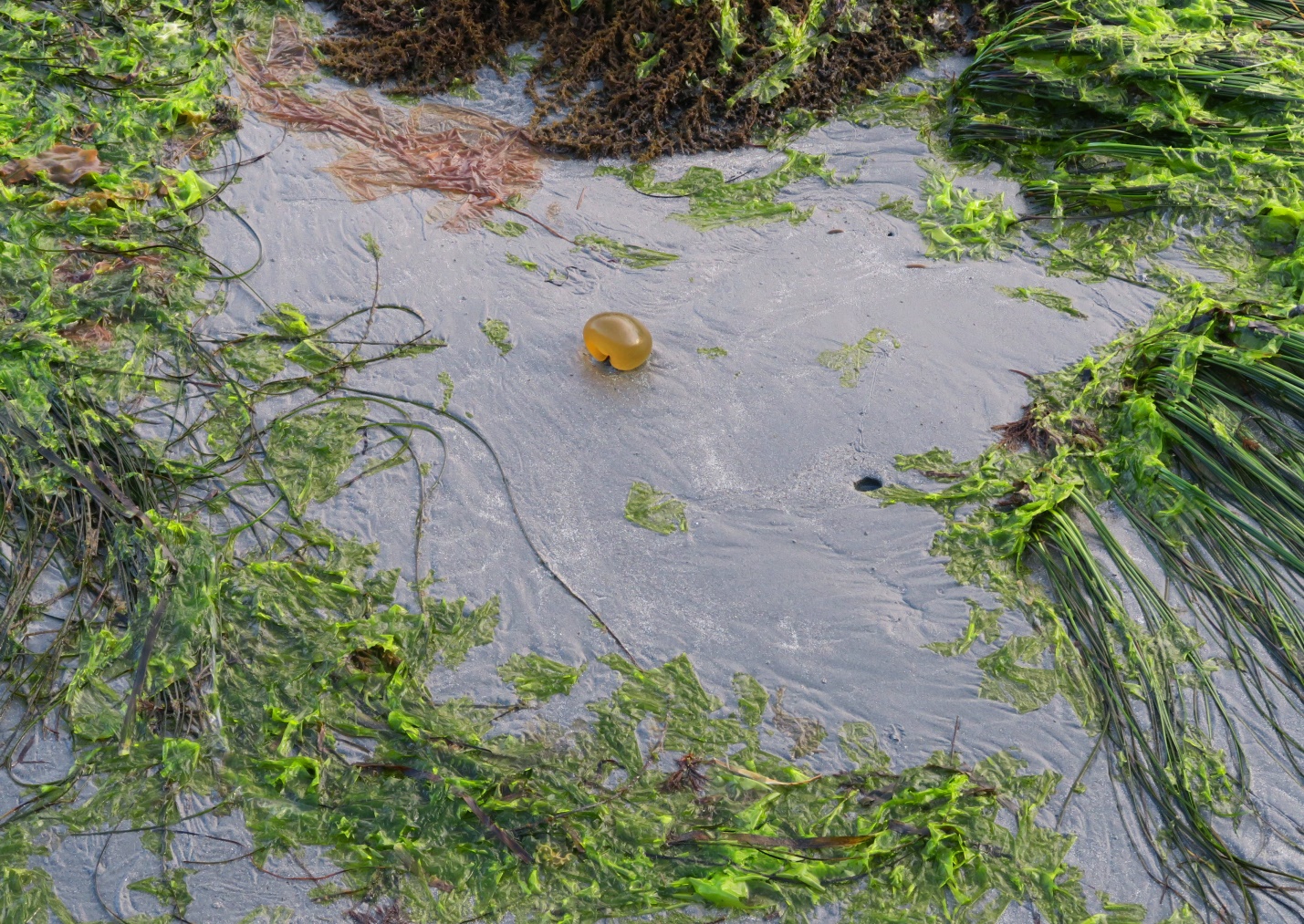
Figure 3: This Colpomenia peregrina individual was found exactly in this position on the beach. The positioning and energy of it seemed to be saying, “Step aside everyone, I have arrived – look at me!” And in an interesting response, all the other sea grass and seaweeds in the area have indeed taken a step back to view this newcomer – all the better to assess its intentions, perhaps? Terrace Beach, Ucluelet, Vancouver Island, B.C., Canada. May 7, 2023. Photo ID 27585 ©Seaweedwhisperings.com
Discussion:
Clinging is one word that came up in our interactions and it is true that this seaweed needs to hang on tightly, at least physically, to its host seaweed or substrate. This can ensure that it has an adequate “home base” from which to live its life, but it also feels very much like Colpomenia may not even grasp for themselves the fact that they are clinging. For them it is a “fact of life” that they do this; for them it is “the way it is” and so awareness of their clinging nature is low to nil. Added to this is the fact that they seem to choose their place to cling and then grow in a carefree and almost totally random manner. There are several photos displayed on this page that show some of the various seaweeds that Colpomenia was epiphytically growing on – we could have included easily a dozen more! So the choice is random, indeed, and may also not be a good choice at all – which would also explain why so many Colpomenia were knocked free and washed ashore on this day. So while there is a lack of careful forethought involved, once they have found their place to grow, they certainly look well satisfied, even rather self-contained or self-sufficient. They are distinctively different looking and are not apologetic for that at all; eccentric a word that fits them, but it is also quite a likeable eccentricity. Perhaps this is all about their rather jovial appearance and their fresh outlook on life. Certainly, when they are plump and full, if you interact with them, they leave you with a smile on your face, too.
One common name for this seaweed is “oyster thief” and this is derived from the fact that sometimes the little sphere of seaweed can become large enough to create greater lift than the gravitational pull downwards of the mass they have anchored to. So Colpomenia can become a “float or buoy” and actually pull its host up and away and on out to sea. Together they then float off and away, at the mercies of the winds, tides and currents; and this is once again the physical “cling”, the NOT letting go writ large. And, for certain, this type of consequence is unintentional. For Colpomenia there is no thought of the possible impact to the ‘other’ with their “clinging”. There is no predicted or anticipated outcome or goal. It would be an accident, perhaps a misadventure, whenever the Colpomenia alga then lifts its host up, and away from its home. So, that initial and forgotten “cling” can ultimately damage that which was clung to in a highly significant way.
So the point of contact, the place to anchor on and to cling to, this involves a host, for sure, but the seaweed seems to show no regard for that host whatsoever – malignant or beneficial. No, the only issue at play is simply if they can find a place to cling that is sufficient to meet their own needs. It is quite the self-serving choice and it is made very early in their life. And the thing about this choice – just precisely where they choose to affix and grow, once the choice is made, well Colpomenia literally has to be torn away, or shoved off, or otherwise violently dislodged before it will leave. Apart from the “floating and lifting” accidental outcomes previously discussed, it does NOT voluntarily leave. This could be said about some other seaweed species too, but with Colpomenia when they are forced away from their home anchor point, they do not necessarily perish. As long as the surface of the little “bulb” or “round brown bag” is intact and holding its pocket of gases, there is the chance, indeed usually a slim one, but there is a chance that they may thrive and even find a new location for their life to continue. That is different compared to what happens with most other algae once they are ripped from their holdfasts.
There is a feeling that this seaweed maybe has the urge to learn more, that they haven’t yet explored things quite enough, so it’s feels as if it is perpetually still searching and trying things out. It is due to this characteristic that Colpomenia will usually avoid committing; they are in the process of ‘still searching’ and it follows that they cannot yet find certainty in themselves sufficient for dedicating or committing to any one thing. In fact certainty is something they may rarely find. Because they are more intrigued, quite entertained by, and still finding pleasure in their desire to keep looking further, to continue their investigations and explorations.
There is a young, or new, or not-yet-jaded quality to them. They can look quite chubby, as if they still have their “baby fat”. They’ve got gifts to work with that they haven’t earned for themselves, which they may have luckily acquired by some fortunate coincidence or heredity. Theirs is not a careless naïveté; it’s just oh so very new, and it’s still got a lot left yet to experience in life. At its best, this quality has them full of wonder and quite carefree. Person 1 thought of Buddhas, in this context we could think of a young Buddha in training who has a strong capacity to laugh at themselves.
The globular shape of a healthy Colpomenia peregrina looks like a pretty well designed and intact bundle or vessel. One could think of it as a “container” but also it seems that there truly isn’t that much that is yet contained therein. Maybe there is the ‘potential’ to hold or contain something; it’s not empty, yet there is much space left available still. As a “vessel”, in the meaning of a ship or large boat, at certain sizes Colpomenia can become like a balloon, lifting heavier, untethered objects afloat or out to sea. It is likely that principally what this “vessel” contains is air. Inside is a whole separate “atmosphere”; in that atmosphere just what might the qualities be? What is the pervading “tone” or “mood” in the Colpomenia atmosphere? It feels like it is one that is a bit uncertain or not yet strongly defined and that is mainly because things are nowhere near complete yet, there’s so much more exploring and trying out and investigating to do. There’s all that potential space yet to fill.
The urge to toss the Colpomenia as a ‘water bomb’ – this was young and playful in nature. It would, upon impact, most certainly have consequences to the seaweed and the target, but we note that this nod to the outcome was only considered because of “outside” restraint that imposed a stop to the play. Possibly the Colpomenia kind of energy has an eternally youthful or not quite grown up quality – indeed, they would throw the water bomb! Maybe they’re a bit eccentric or could even come across as being rather mischievous or comical. Possibly it is also hard for them to be “taken seriously” by others.
We see that often it can be equally hard for them to decide just what they want to take seriously themselves. Perhaps this links to the species name of this seaweed; in Latin peregrina means “to wander”. There is in them a curiosity and an open-minded willingness to try things out. Sometimes these attempts bring surprising results that could fall into the ‘unsuccessful’ category, but the emphasis is mainly a hopeful anticipatory kind of energy that is not discouraged by failures. Settling on some one thing for certain and in a contented way, well, it feels that long before that ever happens they will more likely to grow past the ‘critical point’ and float out to sea..., and they’d do so with a laughing expression on their generously rounded and wide-open expectant faces. At this point, too, they are still exploring, and also facing a very much more daring and dangerous set of circumstances.
Another thing about this “wandering” little ball of algae is it also can become the “newcomer on the scene” showing up as it does, without invitation, from across the open sea. With its pleasurable anticipatory sense of discovery, Colpomenia peregrina can “land” at a new shore and say “Hello, here I am!” It can be a kind of, “Look at me!” attitude. Or, it can be the sentiment of, “Wow, it’s so great to be here!” This idea is hinted at in Figure 3. However, where Colpomenia happens to wash ashore will always be in an area that is already populated with other beings and this new arrival tends to upset the previously established balance. Colpomenia, with its untempered enthusiasm, seems to not care, or to not be aware of the upset its arrival creates. But as the picture (Figure 3) indicates, sometimes Colpomenia’s energy is really felt as an intrusion and the first reaction of others is to back off, give themselves some distance until they have a chance to assess and adapt. Quite often by the time this adjustment by others could be made, Colpomenia will have drifted out to sea again, so the strong possibility exists that once it becomes untethered this seaweed encounters mainly a life of solitude and being largely misunderstood and only ever marginally welcomed – and with that set of circumstances possibly there comes some nostalgia for the connections and associations of its previous home.
Sometimes, too, Colpomenia can pick a poor location to “cling” to as its anchor point. Then if drift logs or row boats or large marine mammals collide with it, well, the little sphere of seaweed will certainly be damaged and torn and possibly dislodged. Is this a case of being too carefree, not discriminating or hesitating enough, about key decisions? Possibly so, and some individuals do truly become damaged and “deflated” as a result of these factors. But on the whole, the energy of this algae seems to roll right back around to, “Oh well, let’s try again!”
So, in spite of these hazards and dangers, on this day and with this Whispering, we found that Colpomenia indeed has no sharp edges; it is smoothly rounded and buoyant and does not approach life with much sign of trepidation or fear. The simple pleasure they derive in their behavior of searching and discovering is a much stronger motivation, and it gives them resilience that you’d possibly expect in a far more experienced or mature being. Maybe one could think of a young Buddha, set out to discover the world with a wide smile on his face...
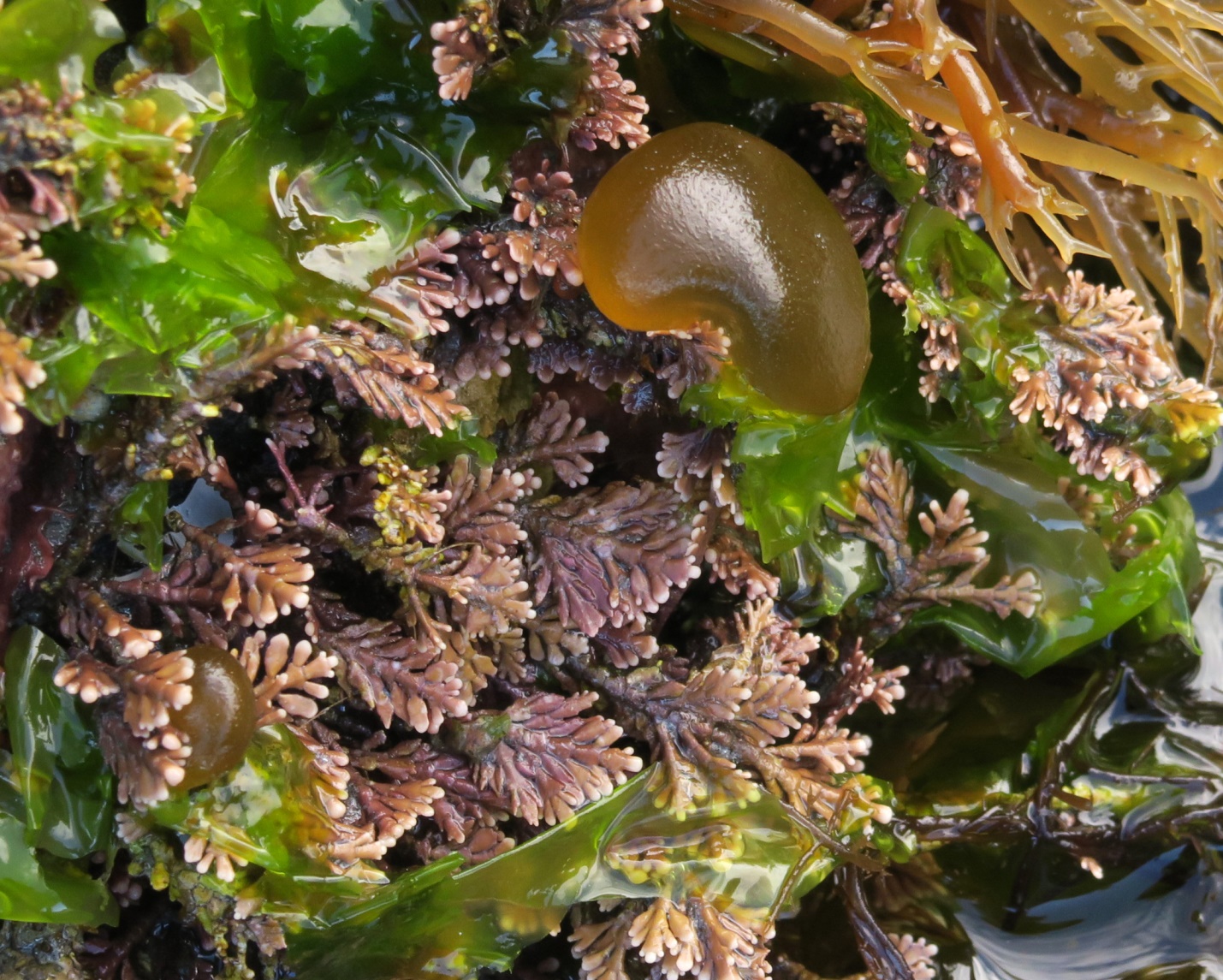
Figure 4: Two young Colpomenia ‘bulbs’ are just getting started (the lower left one is very tiny); these ones are anchored to the pink colored coralline algae which is affixed to the substrate. Terrace Beach, Ucluelet, Vancouver Island, B.C., Canada. May 7, 2023. Photo ID 27586 ©Seaweedwhisperings.com
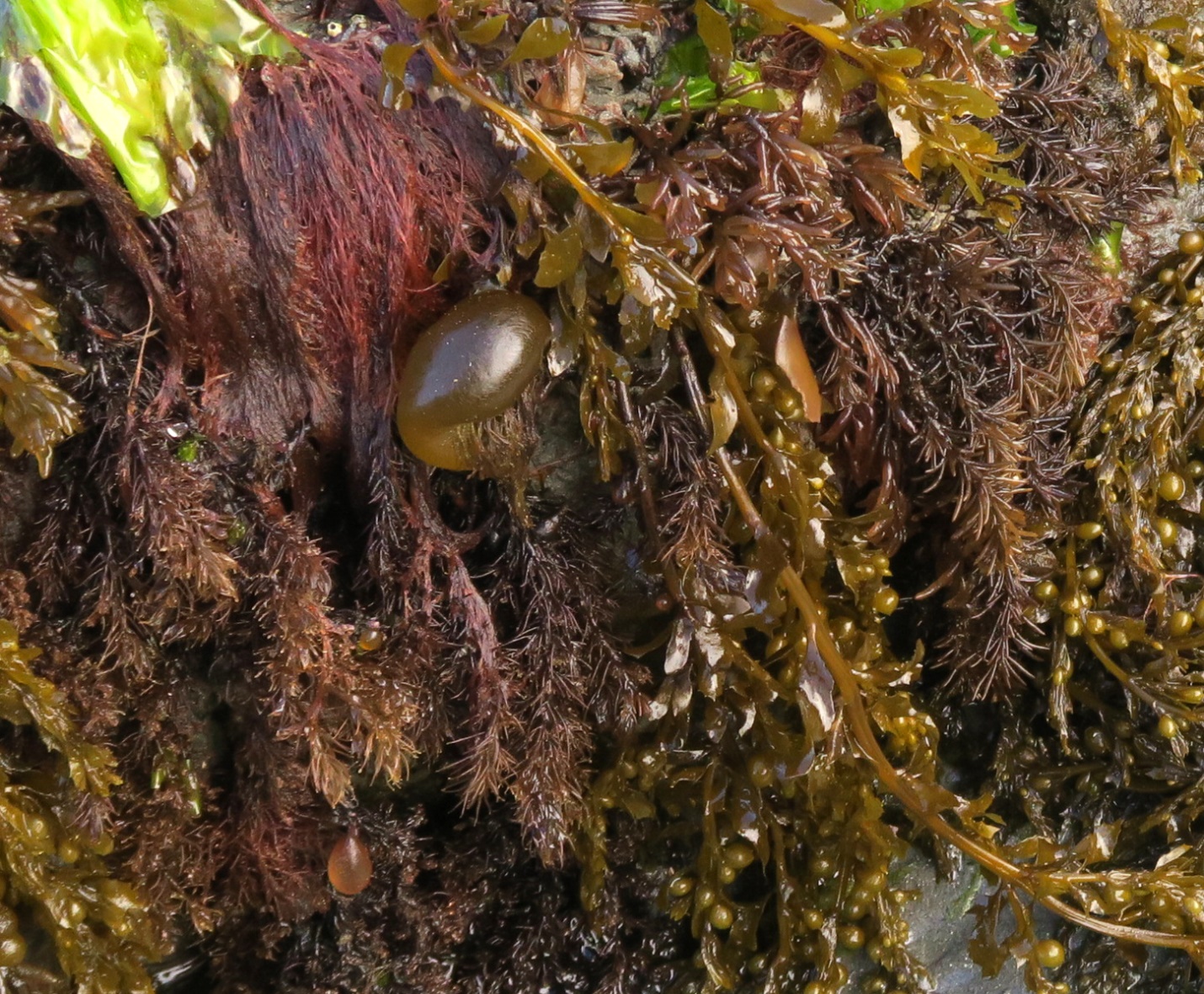
Figure 5: Affixed to the Odonthalia floccosa alga here a young Colpomenia peregrina really “looks” as if it is hanging on to its host with a strong grip. This photo and Figure 4 illustrate just a few of the many places Colpomenia seems to almost randomly choose its anchor point for life. In the lower left quadrant of the photo there is a more tear-drop shaped young alga – this is Halosaccion glandiforme and you can detect that it is a red algae, in contrast to Colpomenia belonging to the brown algae group. Terrace Beach, Ucluelet, Vancouver Island, B.C., Canada. May 7, 2023. Photo ID 27587 ©Seaweedwhisperings.com
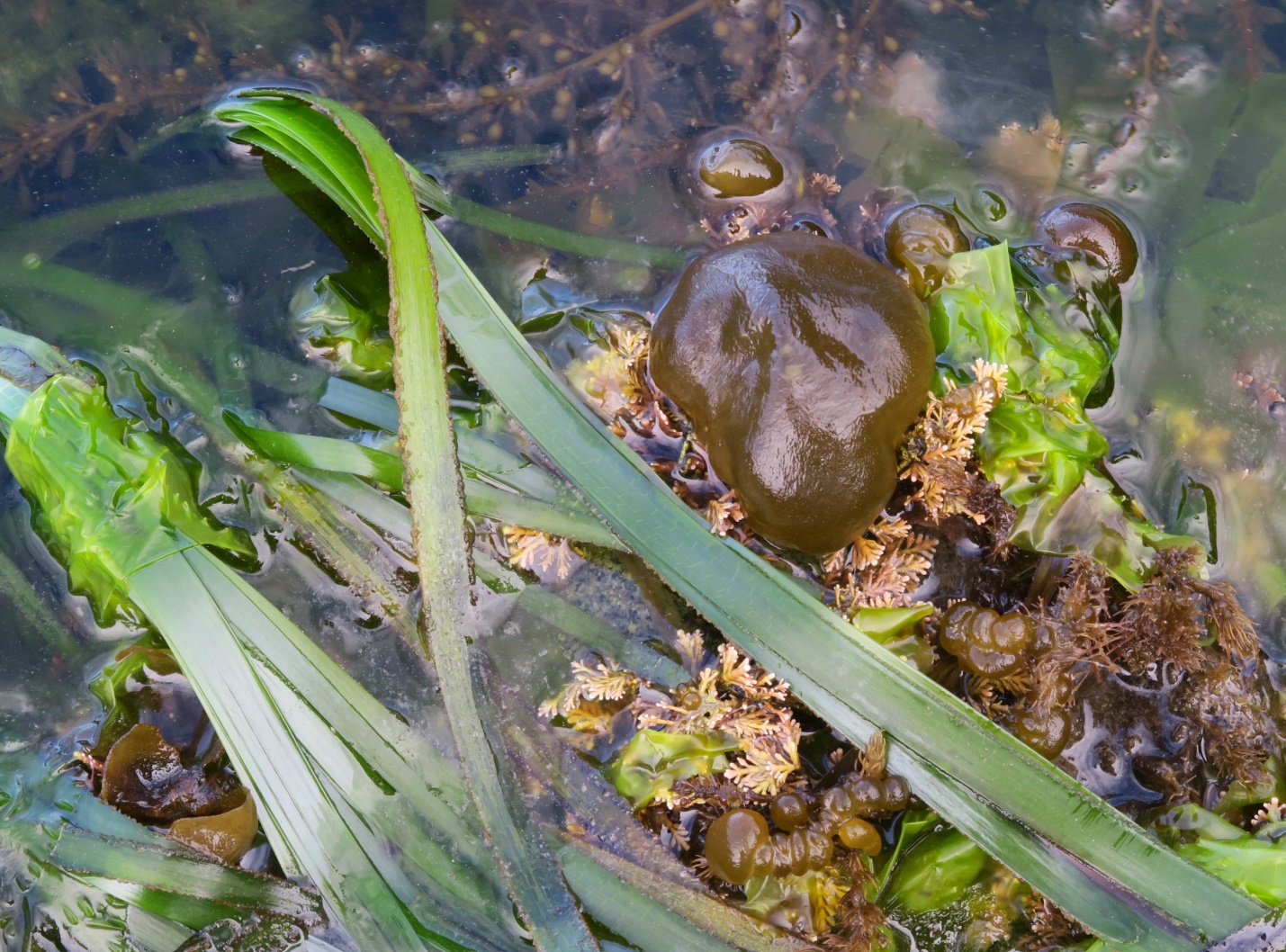
Figure 6: This photo shows Colpomenia peregrina at many stages of development and using yet again other “anchor” points for their home base. The larger semi-furrowed sphere is an obvious mature individual. A few mid-sized ones are “afloat” above it and directly below the largest one, clusters of very young individuals are growing. This species starts out as a solid sphere but as it grows it hollows out and enlarges. On the lower left corner you can see one broken brown sphere tucked in with the eel grass; it looks much like a cracked egg shell. This species can be confused with Leathesia marina, but L. marina crumbles when broken or torn, and C. peregrina tears; the clean torn edge is obvious here. Terrace Beach, Ucluelet, Vancouver Island, B.C., Canada. May 7, 2023. Photo ID 27588 ©Seaweedwhisperings.com
Biology & Natural History Information:
Description:
Thallus is golden brown, globular, reaching 7 to 12 cm (3 to 5 in) in diameter. The thin, smooth, slightly slimy exterior is contrasted by a rough, papery feel on the interior. The hollow thallus tears easily. Small clusters of colorless hairs festoon the surface of this species. It attaches to the substrate with a small holdfast comprised of rhizoidal filaments. Thalli are spherical when young but become furrowed, collapsed and often torn when older. An annual species, it appears in spring or early summer and dies back during late autumn and winter. Young individuals of this species start off solid and then gradually hollow-out as they grow and mature.
Habitat:
This annual grows either directly on rock or is often is epiphytic on other algae in the low intertidal and shallow subtidal in semi-exposed to semi-protected habitats.
Distribution:
Aleutian Islands, Alaska, to southern California; Korea; Japan; Russia; New Zealand; Australia; north Atlantic ocean and Mediterranean. Colpomenia peregrina is an introduced species in many temperate regions, and is described as such in Great Britain; it is believed to have originated from the Pacific.
Remarks:
This species can be confused with Leathesia marina, another saclike brown alga, but C. peregrina tears like paper and L. marina is gelatinous and squashes and breaks up in the fingers. Colpomenia is reported to be soon undergoing substantial taxonomic revision and changes are expected for the taxa in our region; the name of our species of interest here may even change out of the genus Colpomenia.
The popular name “oyster thief” comes from the documented ability of Colpomenia to lift up young oysters they have attached to and float them out to sea. As with other seaweeds that have the ability to retain gas within their structure, Colpomenia can “lift” the very substrate (or animal) they are attached to once they reach critical size. Then, well, they will be wandering, destined to become “introduced” species in new regions of the world’s oceans.
Classification:
Phylum: Ochrophyta
Class: Phaeophyceae
Order: Ectocarpales
Family: Scytosiphonaceae
Genus: Colpomenia
Species: Colpomenia peregrina Sauvageau 1927
Former name(s): Colpomenia sinuosa var. peregrina.
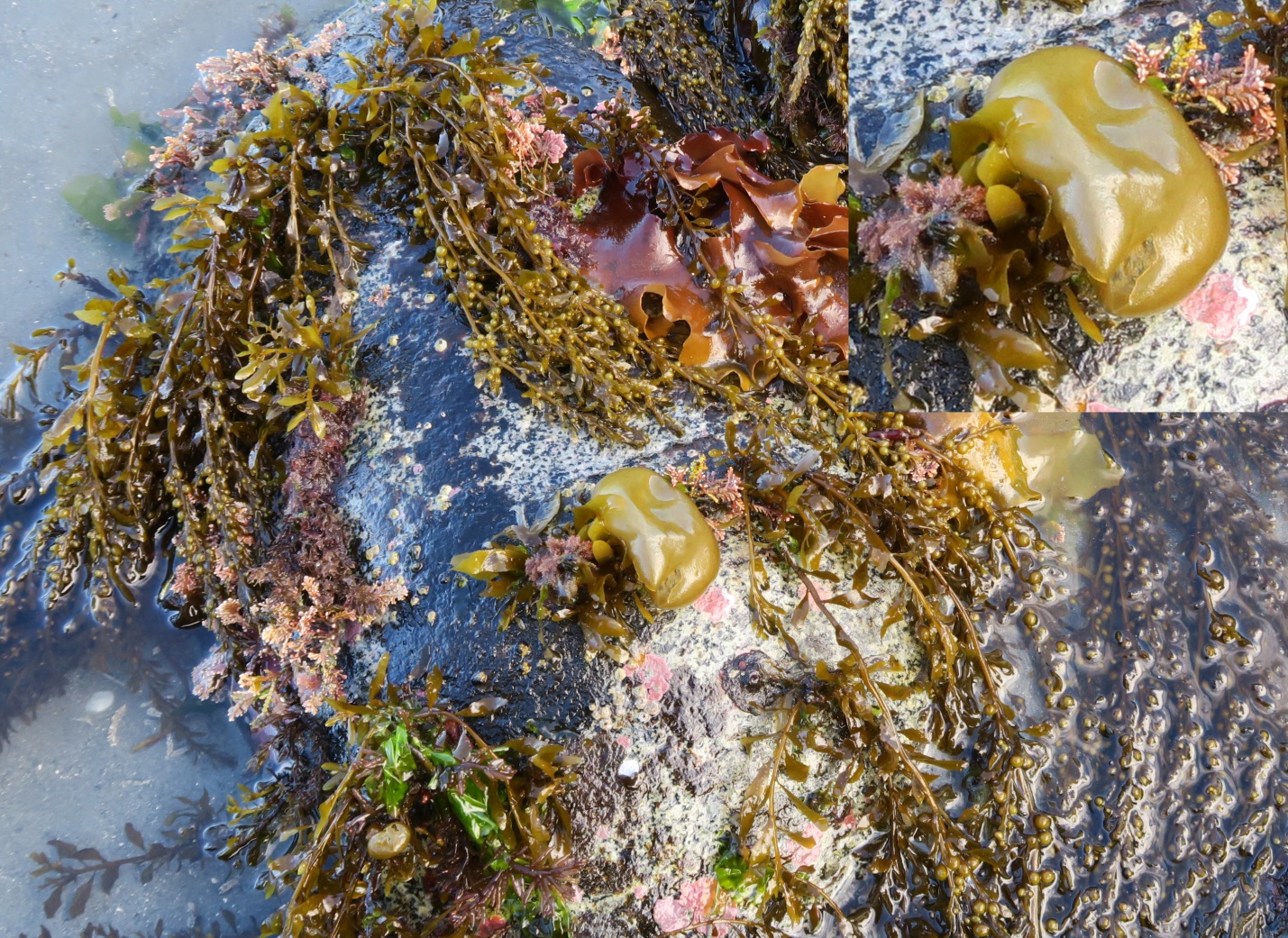
Figure 7: Situated on the crest of this small boulder the holdfast and some broken thalli of Sargassum muticum can be seen. Also some fronds of pink coralline algae grow here and one Colpomenia peregrina alga. In the upper right corner of this image the Colpomenia is enlarged and it shows the damage that has torn and “deflated” this normally plump brown bulb. Positioning oneself at the top of a boulder is likely a bit too exposed to damaging blows as this individual learned; it will no longer thrive. Terrace Beach, Ucluelet, Vancouver Island, B.C., Canada. May 7, 2023. Photo ID 27589 ©Seaweedwhisperings.com
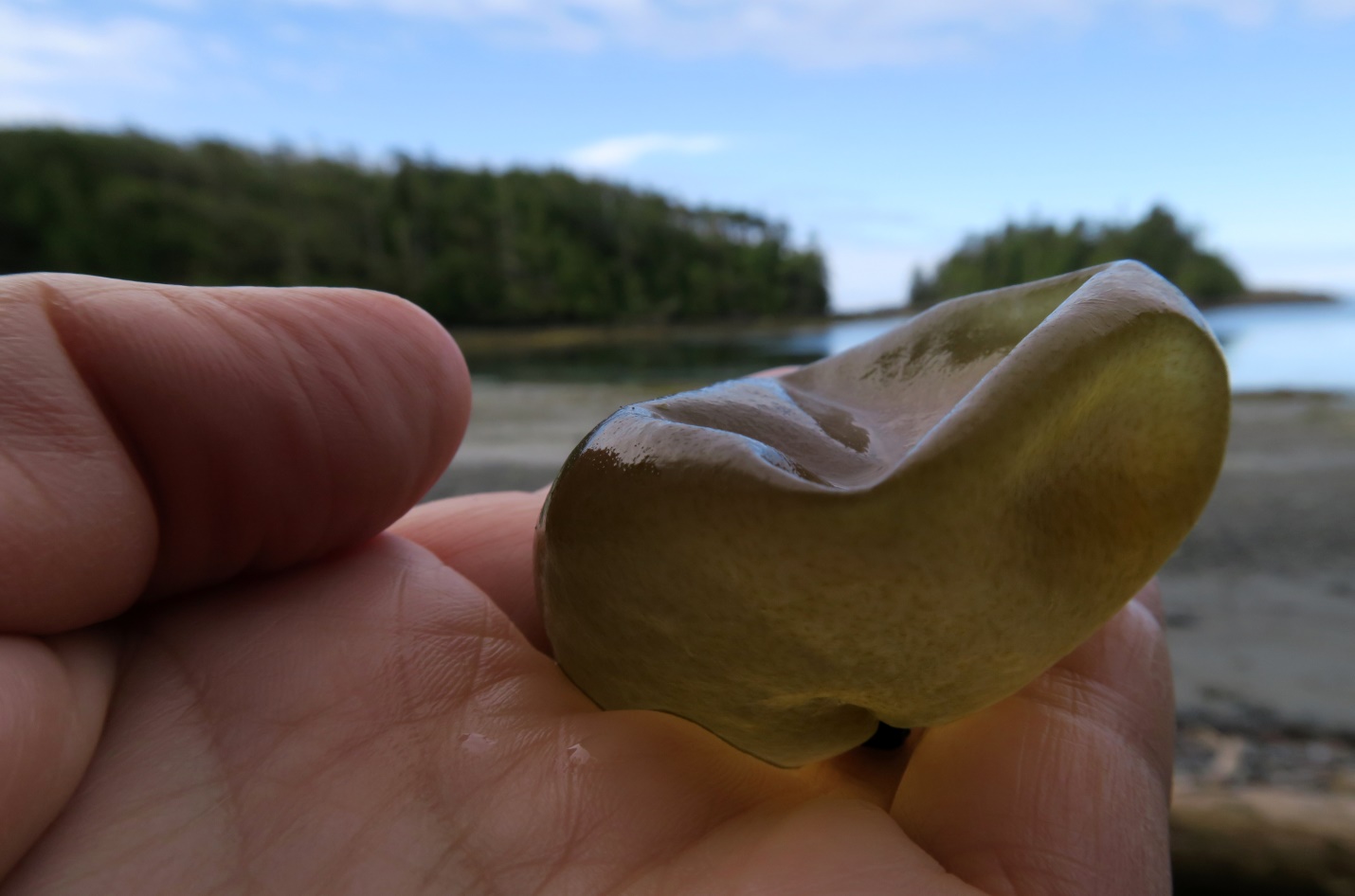
Figure 8: This photo seems to capture a sense of the ‘desire-to-wander’ trait that is a component of Colpomenia’s energy. What distant island beach will it next visit...? Will it arrive intact...? How will it be received...? And where might it next wander to from there...? Terrace Beach, Ucluelet, Vancouver Island, B.C., Canada. May 7, 2023. Photo ID 27590 ©Seaweedwhisperings.com
![]()